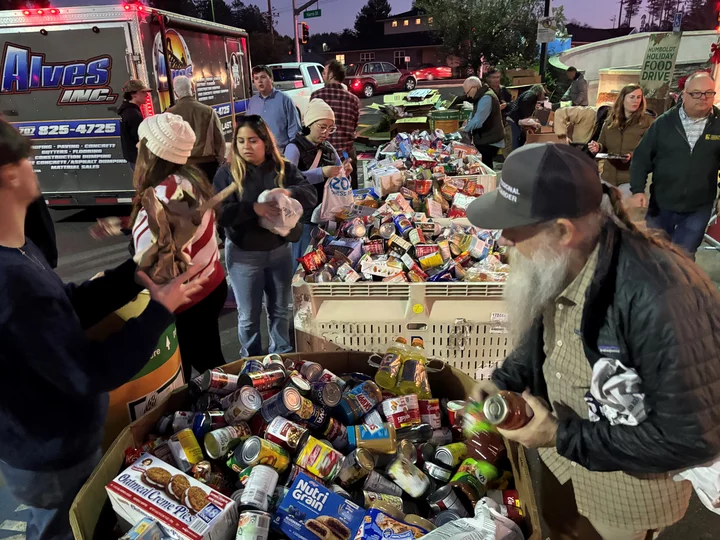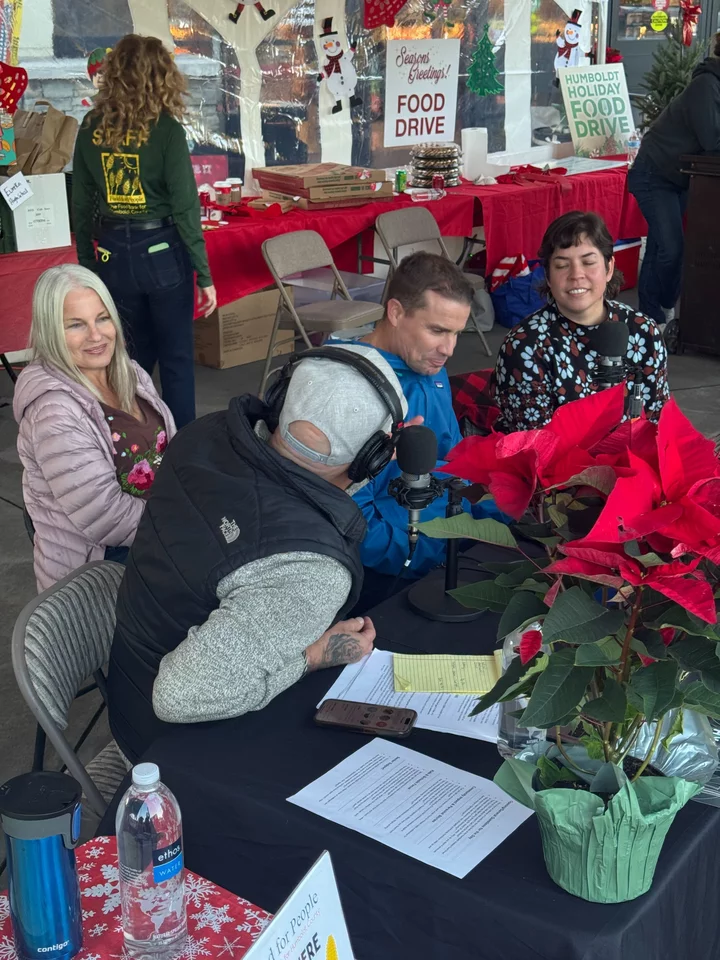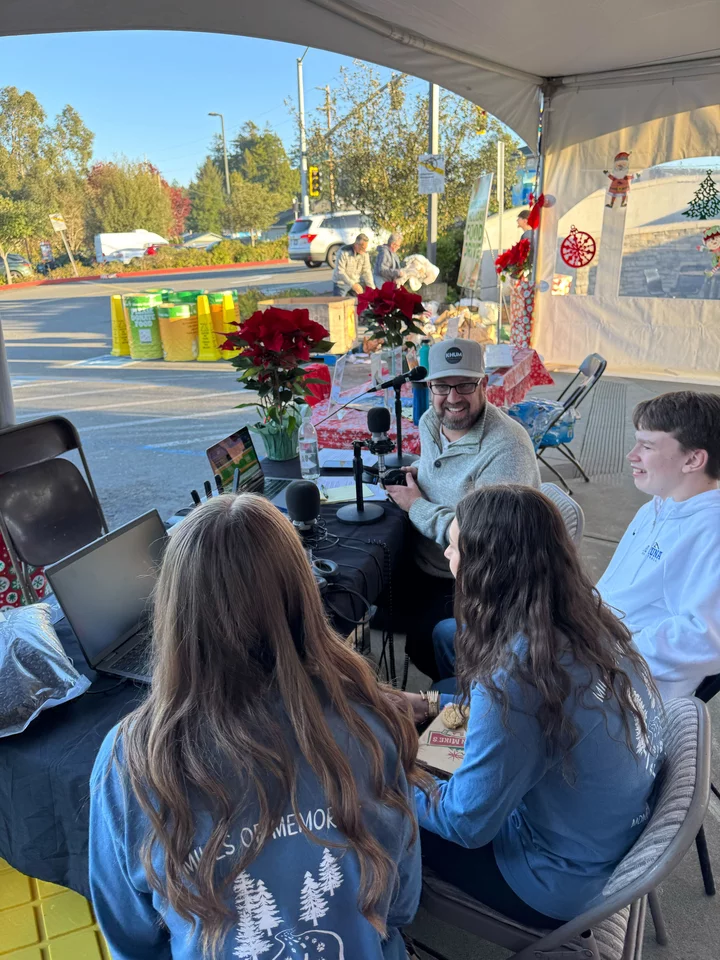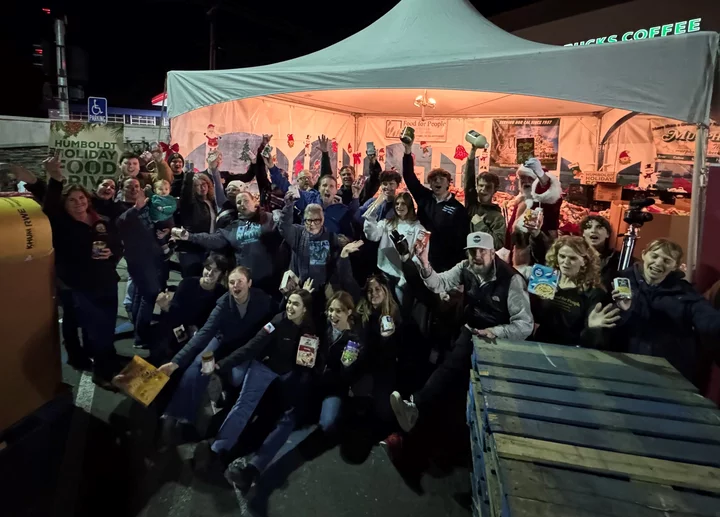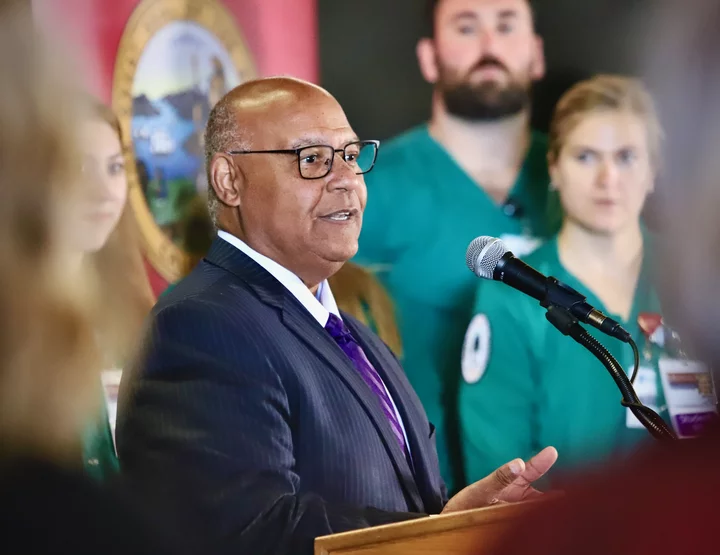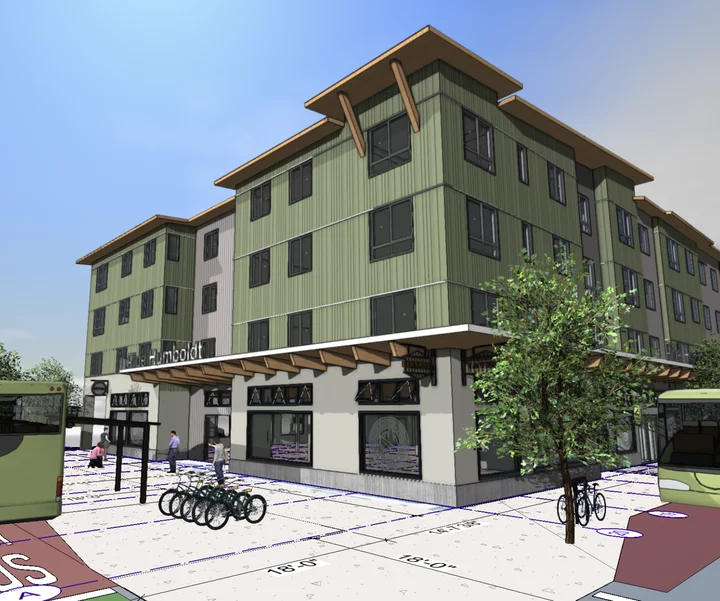In Leaked Excerpt of Guilty Plea, Former Fortuna Councilmember Kris Mobley Details $586K Embezzlement Scheme
Ryan Burns / Friday, Dec. 12, 2025 @ 4:18 p.m. / Courts
On Wednesday, former Fortuna City Councimember Christina “Kris” Ann Mobley pleaded guilty in federal court to four counts of felony fraud. The crimes were part of a two-year embezzlement scheme Mobley executed while employed as a business manager at Fortuna-based Beacom Construction Co.
Mobley, who was elected to the Fortuna City Council in 2022, abruptly resigned in January in the midst of an FBI investigation into her crimes. She was indicted just over a week later for allegedly stealing more than $500,000 from her employer over the course of almost three years.
The Outpost has obtained an excerpt from the sealed plea agreement in which Mobley acknowledges her guilt and explains in detail how she fraudulently issued company checks to herself, arranged electronic payments to cover her personal credit card debts and falsified her vacation time and payroll checks, ultimately embezzling more than $586,000 from Beacom Construction.
Mobley pleaded guilty to just four of the 10 counts listed in her indictment. In the leaked plea statement she says was effectively the chief operating officer at Beacom, giving her broad access to the firm’s accounting and bookkeeping systems.
Starting in or around January of 2022, Mobley issued a series of checks from the company’s business bank accounts to cover personal expenses, including cash advances at casinos, mobile gambling, restaurants and more.
Mobley also admits to using wire services to arrange nearly $300,000 in electronic payments from Beacom’s bank accounts to her own Capital One credit card account. She had access to blank, pre-signed checks from the company’s owner, for use when he was out of town, and from August 2022 through October 2024 she issued 23 of those checks to herself totaling roughly $51,900, according to the statement.
Lastly, Mobley admits to falsely inflating her vacation time, overstating the number of hours she worked and giving herself unauthorized bonuses over a span of about two years.
Mobley’s sentencing hearing is scheduled for March 18, 2026.
###
PREVIOUSLY
- Fortuna City Council Member Kris Mobley Resigns as FBI Investigates Embezzlement and Theft Allegations, According to City Officials
- Fortuna City Officials Knew About the FBI Investigation Into Former Councilmember Kris Mobley Two Months Before She Vacated the Position
- Former Fortuna City Council Member Indicted on Three Counts of Fraud
BOOKED
Today: 5 felonies, 11 misdemeanors, 0 infractions
JUDGED
Humboldt County Superior Court Calendar: Friday, Jan. 2
CHP REPORTS
Us101 S (HM office): Traffic Hazard
150 Nelson Ln (HM office): Traffic Hazard
1600 Mm36 E Hum 16.00 (HM office): Closure of a Road
9731 Mm101 N Men 97.30 (HM office): Trfc Collision-No Inj
Ryan Creek Rd / US101 (HM office): Traffic Hazard
ELSEWHERE
RHBB: Highway 36 Closed Again at Grizzly Bluff Slides After Boulder Hits Vehicle
RHBB: City of Trinidad Urges Residents to Boil Water After Repairing Water Main Leak
WHAT A HAUL! Humboldt Raised 23.5 Tons of Food and $63,000 During the Annual Holiday Food Drive
LoCO Staff / Friday, Dec. 12, 2025 @ 2:27 p.m. / :)
Photo: McGuire’s office.
Press release from the office of Sen. Mike McGuire:
Senator McGuire’s 10th annual Humboldt Holiday Food Drive made history yesterday by rallying the community for its biggest day of giving yet, delivering a monumental day of generosity for Food for People, Humboldt County’s food bank. The record-breaking event brought in 23.5 tons of food along with a WHOPPING $63,000 in financial donations, all headed directly to support hungry families across Humboldt County.
Now the largest Food Drive on the North Coast, the Food Drive is powered by a partnership between Senator McGuire, Food for People, KHUM Radio, North Coast News, and six local high schools: Arcata, Eureka, Ferndale, Fortuna, McKinleyville, and St. Bernard’s. This year, Food for People faced the biggest challenge yet in the organization’s 50-year history with massive federal funding cuts to SNAP, the Supplemental Nutrition Assistance Program, stripping away food assistance from 5.5 million needy Californians each year.
Going into the holidays with this year’s historic demand, local businesses and the Humboldt community majorly stepped up the generosity to support Food for People’s 26 food pantries, which serve an average of 21,000 residents every month. In 2024, the organization distributed 2.8 million pounds of food to low-income residents; of those served, 25% are children and 25% are seniors.
“Ten years strong and Humboldt is still showing the world that the North Coast is the most generous place on earth. This year has been incredibly tough for so many families, and the need has truly never been greater. Thousands of students, donors, and neighbors stepped up to make sure no one goes hungry this holiday season,” said Senator McGuire. “This year’s food drive smashed all records, and it didn’t happen by accident — it happened because Humboldt shows up, year after year, for families who need it most.”
Taking home the Golden Can Award this year was, McKinleyville High School once again collected the most food this year with an incredible 17,291 pounds, while Fortuna High School brought in the most financial contributions with $3,340 collected for Food for People. Both schools will receive the coveted Golden Can Award and a $750 check from Senator McGuire for their efforts to be used toward their next school party.
“We are blown away by the generosity last night! Our community is facing a truly unprecedented need this year and the giving we saw yesterday was nothing short of inspiring,” said Carly Robbins, Executive Director of Food for People. “For ten incredible years, Sen. McGuire has brought thousands of people together to help us feed families in need. We’re so thankful for Senator McGuire, for our dedicated high school partners, and for every person who donated food or funds. This outpouring of support means our warehouse will stay stocked for months ahead.”
KHUM DJ Toby Tullis talks with Eureka Mayor Kim Bergel, McGuire and Supervisor Natalie Arroyo at the big event at Eureka Safeway yesterday. Photo: Roger Harrell.
Tullis and teen food-drivers. Photo: Roger Harrell.
Take a bow. Photo: McGuire’s Office.
PG&E Extends Deadline for Comment on Potter Valley Project Dam Removal; Friends of the Eel Urges Humboldt People to Make Their Voices Heard
LoCO Staff / Friday, Dec. 12, 2025 @ 1:46 p.m. / Environment
From left: Cape Horn Dam, Scott Dam. Photos via PG&E.
Press release from Friends of the Eel:
PG&E has submitted an application to surrender its license for the Potter Valley Project, and to remove the two defunct dams in the Eel River headwaters. This is a smart economic move, as the project has not generated electricity for over 4 years, and what it did produce over the last 20 years was less than 1% of PG&E’s entire hydropower portfolio. This failed hydroelectric project is costing ratepayers about a million dollars a year for absolutely no benefit, while continuing to cause significant ecological harm to the Eel watershed.
We are currently at a critical juncture – the public’s first opportunity to speak to federal regulators about this project and encourage them to approve PG&E’s plan for dam removal with no delay. The Federal Energy Regulatory Commission (FERC) need to hear from our community about how this plan is broadly supported and benefits public interest. The comment deadline has just been extended, we now have until Friday, December 19 at 2 p.m. to file comments.
The disinformation campaign coming from the MAGA movement has been well-funded and successful in generating ill-informed opposition to this project. Water users who stand to benefit from a more reliable diversion infrastructure, or water users who may have never received any Eel River water, are voicing loud opposition. We must be louder to ensure the Eel River dams are removed in time to save our struggling native fish. You comment can make a difference!
The Potter Valley Project includes an inter-basin diversion of water from the Eel River to the Russian River. The current plan allows for the Eel Russian Project Authority to use some of the existing infrastructure to develop a new dam-free diversion under different rules that are more protective of Eel River habitat, but will continue to provide water supplies to users in the Russian River.
Dam removal is the single most important action we can take to support recovery of the Eel’s still-wild native fish, and allow steelhead to return to over 280 miles of prime habitat in the upper basin. Dam removal will also remove habitat that is ideal for invasive pikeminnow, which thrive in the warmer waters of the Lake Pillsbury Reservoir.
Please take a few moments today to write a comment in support of Eel River dam removal. Use the links below to find instructions for commenting, suggested talking points, a sample letter, and additional information about the Potter Valley Project.
Instructions for commenting here.
Sample letter to FERC here.
Watch a presentation - Why Eel River Dam Removal is Urgent.
Dr. Keith Flamer, College of the Redwoods’ Longtime President, Will Step Down From That Role One Year From Now
LoCO Staff / Friday, Dec. 12, 2025 @ 1:22 p.m. / Education
Flamer at the inauguration of the Cal Poly/CR Health Care hub. File photo: Andrew Goff.
Press release from College of the Redwoods:
College of the Redwoods President Dr. Keith Flamer has announced that 2026 will be his final year leading the College. He has formally notified the Board of Trustees of his intent to conclude his service at the end of his current contract on December 31, 2026. The Board will formally acknowledge his notice at its meeting next week.
The Board of Trustees and Dr. Flamer have been working collaboratively for several months to update board policies and administrative procedures related to the presidential search. The Board will begin a formal search for the College’s next president early in the Spring 2026 semester. The process is expected to be thoughtful, transparent, and inclusive.
Board President Colleen Mullery noted that “leadership requires trust, courage, commitment, vision, and the ability to bring disparate groups together to work toward a common goal,” adding that College of the Redwoods “has been blessed with the leadership provided by Dr. Keith Flamer during his tenure as President. While higher education has experienced unprecedented turbulence, he has remained steadfast in his unflinching support for CR students, faculty, staff, and the community.
Dr. Flamer joined College of the Redwoods in July 2006 and has served the institution for nearly two decades, first as Vice President of Student Services, then Vice President of Student Services and Instruction, and for the past ten years as President. While the decision was difficult, he stated that the College is well positioned for a leadership transition.
Under Dr. Flamer’s leadership, the College resolved significant accreditation and financial challenges, strengthened community partnerships, expanded distance education infrastructure, improved employee compensation, and fully recovered enrollment lost during the pandemic. The College is now positioned to surpass enrollment targets and grow general fund revenue. Significant investments have also been made in faculty and in healthcare and career education programs.
Major facilities projects undertaken during his tenure include the Creative Arts Complex, community stadium renovation, and the new PE Complex and Fieldhouse. Upcoming projects include affordable student housing on the Eureka Campus, the Del Norte Healthcare Education Training Center and renovation, and the joint Cal Poly Humboldt/CR Healthcare Education Hub.
“None of this progress would have been possible without the dedication of our faculty, staff, students, administrators, the Board of Trustees, and our community partners,” Dr. Flamer said. “It has been the honor of my career to serve College of the Redwoods.”
Dr. Flamer will remain fully engaged as President through the end of his contract and will continue advancing the College’s priorities while supporting a smooth leadership transition.
(VIDEO) Power Line Erupts in Flashes, Bangs and Smoke Near Eureka High, Causing a Small Outage
Ryan Burns / Friday, Dec. 12, 2025 @ 12:41 p.m. / News
###
A power line draped above I Street near Eureka High School shorted out in dramatic fashion this morning, sending sparks and smoke into the air as electricity danced across the cable.
The footage above was sent to the Outpost by Nadia Eberman, who captured the light show from her parked car. She said drivers stopped before passing under the live wire, and Humboldt Bay Fire responded to the scene.
Commenters online diagnosed the event as a phase-to-phase short, which occurs when two conductors in a three-phase system make direct contact. Such short circuits can create a massive surge of current, triggering intense arcing, bright flashes, loud bangs and significant heat.
The zapped line did cause a power outage along a block of I Street, though it only affected 14 customers, according to PG&E.
Eureka’s Long-Awaited EaRTH Center Awarded $12 Million in Grant Funds; Construction Slated to Begin Spring 2026
Isabella Vanderheiden / Friday, Dec. 12, 2025 @ 12:22 p.m. / Housing , Local Government , Transportation
The northeast corner (Third and G streets) of the Eureka Regional Transit & Housing Center. | Rendering via the City of Eureka.
###
Nearly four years after it was approved by the Eureka City Council, the EaRTH Center has finally secured the funding needed to move ahead to construction. If everything goes according to plan, the city will break ground on the four-story housing and transit development in spring 2026.
“The EaRTH Center represents the kind of integrated, community-focused development that Danco is committed to delivering,” Danco Communities Project Manager McKenze Dibble said in a press release issued this morning. “By pairing affordable housing with improved public transit, we are helping to build a more connected, equitable, and sustainable future for Eureka.”
The EaRTH Center, short for the Eureka Regional Transit & Housing Center, will replace two city-owned parking lots on Third Street between G and H streets, behind Lost Coast Brewery. The development will host the Humboldt Transit Authority’s regional transportation hub on its ground floor, plus five commercial spaces for businesses. The upper floors will feature 45 residential units designated for low- and very-low-income households, including three studios, 18 one-bedroom, 13 two-bedroom and 12 three-bedroom apartments, plus one two-bedroom unit for on-site staff.
The project, a partnership between the City of Eureka and the Humboldt Transit Authority (HTA), has changed quite a bit since it was first approved in February 2022 by the city council.
When plans for the EaRTH Center were drawn up several years ago, the development was billed as a 30-unit housing project for students and traveling medical staff. At that time, the city was working with Cal Poly Humboldt and Servitas, a student housing management company, to create housing for incoming students, but the plans eventually fell through due to expenses.
“We’ve had three different iterations of what we’ve planned on doing there,” City Manager Miles Slattery told the Outpost. “And then we reached out to Danco and [Danco President] Chris Dart, and they have been amazing partners, along with their architect, Garrett [McSorely]. They’ve brought this to reality based on their expertise, but also their desire to work with HTA to build a transit center.”
The HTA has secured over $12 million in grant funding for the project from the Transit and Intercity Rail Capital Program, the Greenhouse Gas Reduction Fund and the SB 1 Program.
Design review is complete, but Danco still has to secure a few building permits before the city can break ground on the project. Construction is slated to begin in May of 2026 and wrap before the end of 2027.
Asked is the city is still looking into the possibility of building a parking garage across the street from the EaRTH Center — on the southwest lot at Third and G streets, where the old City Hall used to be — Slattery said the Humboldt County Association of Governments (HCAOG) is working on a feasibility study to assess the parking need in downtown/Old Town Eureka.
More information can be found in the following press release from the Danco Group:
Eureka, CA — The Danco Group is proud to announce that the Eureka Transit Housing Center, also known as the EaRTH Center, has officially secured its final portion of tax credit funding, clearing the way for construction to begin on one of Eureka’s most transformative community projects in decades.
Developed in partnership with the City of Eureka and the Humboldt Transit Authority, the EaRTH Center will convert a city-owned parking lot between G and H Streets in Old Town Eureka into a vibrant, mixed-use hub that integrates sustainable multimodal transportation infrastructure, community services, and high-quality affordable housing.
“I’m thrilled to see this project advance! We are so excited to have a beautiful new Transit Center in downtown Eureka that blends transit infrastructure with new housing and office space. This will add to the vibrancy of the County’s seat in Eureka. Huge thanks to everyone who has made this possible,” said Natalie Arroyo, Chairperson of the Humboldt Transit Authority Board of Directors.
Originally conceived as student housing, the EaRTH Center has evolved over the past three years to meet the region’s growing need for low-income and very-low-income housing. The four-story development will include:
- 45 affordable housing units (3 studios, 18 one-bedrooms, 13 two-bedrooms, 12 three- bedrooms), plus 1 two-bedroom unit for on-site staff.
- A multimodal hub on the ground floor bringing together public transit, bicycle, scooter, pedestrian, rideshare, taxi, Amtrak, and other mobility services. Six leasable commercial spaces for local businesses
- Affordable housing amenities to include a community room and fitness center, outdoor second-floor patio playground, community laundry and study room on each residential floor, secure indoor bicycle storage on ground floor and floors 3 & 4, on-site management office, and lobby
- Enhancing Mobility and Sustainable Infrastructure
The project also introduces key improvements to Eureka’s transportation network:
- Improved bus stop infrastructure on H Street and 3rd Street for safety and accessibility.
- A Class 1 bike lane on H St between 3rd and 4th streets will help connect the Bay Trail to the H St bike trail
- The transportation hub that will facilitate seamless transfers across all intercity and intercounty routes operating in the County
- Bicycle lane improvements and striping on H Street to connect with the City’s recent projects.
- New restrooms, water-filling station, and a place to stop and enjoy as part of your commute.
The Humboldt Transit Authority is contributing over $12 million in grant funding from the Transit and Intercity Rail Capital Program, sponsored by the California State Transportation Agency with funds from the Greenhouse Gas Reduction Fund and the SB 1 Program.
“The EaRTH Center represents the kind of integrated, community-focused development that Danco is committed to delivering,” said McKenze Dibble, Project Manager for Danco Communities. “By pairing affordable housing with improved public transit, we are helping to build a more connected, equitable, and sustainable future for Eureka.”
###
###
PREVIOUSLY:
- EaRTH Center a Go: Eureka Council Approves Ambitious Housing/Transit Development Downtown, Despite Parking Concerns
- Citing Critical Need for Housing in Eureka, City Council Choose Danco to Develop the EaRTH Center, a Long-Awaited Housing and Transit Hub in Downtown Eureka
- Design Review Committee Narrowly Approves New Plans for Eureka’s EaRTH Center
Court Ruling Could Force Trump Administration to Release Mental Health Funds for Humboldt County Schools, Among Others
Vani Sanganeria / Friday, Dec. 12, 2025 @ 11:42 a.m. / Courts , Education , Government
Photo via McK High Facebook page.
PREVIOUSLY
###
This story was originally published by EdSource. Sign up for their daily newsletter.
###
California school districts were bracing for their mental health grants to be cut at the end of the month, but a recent court ruling could force the Trump administration to temporarily release the remaining funds used for school social workers and counselors.
A court ruling on Dec. 4 rejected the Trump administration’s attempt to stall a preliminary injunction in which a federal judge ordered the U.S. Department of Education to release millions of dollars in grants for school mental health workers.
The ruling is part of an ongoing multi-state lawsuit alleging that the administration’s sweeping cancellation of mental health grants — $168 million for California schools — in April was unlawful and jeopardized services “critical to students’ well-being, safety and academic success” in rural and underserved parts of the country.
The mental health program, which was funded by Congress after the 2022 school shooting in Uvalde, Texas, included grants meant to help schools hire more counselors, psychologists and social workers.
In an April discontinuation letter, the Trump administration accused grant recipients of violating “merit, fairness and excellence in education,” broadly targeting diversity, equity and inclusion in the grant program.
Amanda Mangaser Savage, an attorney at the nonprofit law firm Public Counsel, said the injunction does not issue a final ruling on the legal basis of the cancellation. It issues a temporary release of funds, she said, that is not guaranteed to be permanent or timely enough to retain all mental health worker roles before Dec. 31, the cutoff for funds listed in the cancellation notice.
“So it’s not like someone flips a switch and all of a sudden everybody gets money,” Savage said. “It’s that the Department of Education can’t rely on these unlawful considerations that it relied on to discontinue the grants.”
Injunctive relief applies only to a subset of grantees who had submitted declarations of harm to the court, including McKinleyville Union School District and Northern Humboldt Union High School District in Humboldt County. Represented by Public Counsel, McKinleyville Union also filed its own independent lawsuit in October, seeking a release of nearly $6 million in remaining mental health grant funds, Savage said.
The ruling restores roughly $3.8 million in Madera County in the Central Valley and $8 million in Marin County in the Bay Area.
Jack Bareilles, the grants and evaluation administrator with the Northern Humboldt Union High School District, said the court ruling is a step in the right direction, but that it is not enough to retain the four social workers and project staff, as well as prospective social work interns, he expects to lose, unless a final ruling guarantees restored funds for the district. Northern Humboldt is still expecting to lose more than $6.5 million in grant funds.
“We’re happy that the panel ruled the way they did, but this administration has made a habit out of continuing to appeal all the way up to the Supreme Court,” Bareilles said. “It doesn’t give us any certainty at this moment.”
Unlike in McKinleyville Union’s independent lawsuit, Northern Humboldt and other school districts are not the main plaintiffs in the multi-state lawsuit, which was filed by a coalition of 16 states in June. Bareilles said that he is also uncertain whether the injunction would release funds to all 49 grant recipients, or only those who declared support for the lawsuit, in California. If or when the district does receive its funds, Northern Humboldt would not be able to fully recover its team of school counselors and social workers, he said.
“It will be very hard to regain the momentum,” Bareilles said. “We can’t even rehire in some cases, because we’re in the middle of the school year, and people have already taken other jobs.”
Grant provided funds to hire more counselors
Before the grant, McKinleyville Union had only one school counselor per 850 students. Since then, it has been able to hire five more counselors. If the district does not receive funds in time, the school could lose these workers, as well as a mental health grants administrator.
“And, most problematically, students start to develop relationships with the mental health providers that are in their schools. If all of a sudden those positions are cut, in some ways that’s even more harmful than if you would never start them at all,” Savage said. “Because students believe that they’re going to have this care and then all of a sudden, they don’t.”
Through the grant, Northern Humboldt has provided more than 3,600 additional students with mental health services since 2023 and has helped credential and employ over 25 mental health clinicians in the county. Bareilles is hopeful that the restored funds will allow for the continued training of prospective social workers and school counselors.
“But for our students, there’s hundreds of kids this year who have not had a person to serve them because that person wasn’t there,” Bareilles said. “That’s just the sad nature of this process.”
In Humboldt County, where McKinleyville Union and Northern Humboldt Union are located, more than half of all youths have experienced traumatic events like abuse or homelessness, according to Savage. The county also has the highest number of Native American youth in California who rely on grant funds to receive services like grief intervention and suicide prevention, she said.
“What’s really going on here is the Trump administration is having an ideological disagreement with the Biden administration, and it’s basically throwing these kids under the bus,” Savage said. “It just shows how little they actually care about the mental health of these students.”
###
The Associated Press contributed to this report.


